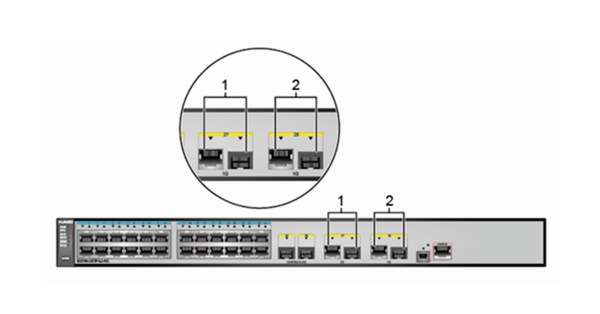What is the difference between the SFP port and the Combo port?
2017-09-30
What is a Combo port?
Combo interface, also known as optoelectronic multiplexing interface, is the switch device panel on the two Ethernet ports (an optical port and an electrical port). Combo electrical port and its corresponding optical port is logically multiplexed, the user can choose according to the actual network of one of the use, but they can not work at the same time. When one of the port is activated, the other port is automatically disabled.

What is the SFP port?
SFP port is a subset of Gigabit Ethernet, when the SFP port using fiber Gigabit link, it is Gigabit Ethernet; in the Ethernet switch, regardless of the electrical port, optical port link layer with a protocol, the only difference is physical layer, that is media; SFP is a description of the physical layer. SFP port can be used to plug the SFP module, plug in the electrical port SFP module can be used when the electrical port, you can connect the network cable; if plugged in the SFP module can be used when the optical port, you can connect the fiber.
What is the difference between the SFP port and the Combo port?
1.You can use a pair of twisted-line ports or SFP slots for combination port pairs, but not at the same time.
2.If you connect a combination port pair to a network device with a twisted port and an SFP slot, the SFP slot is preferred and the twisted pair port is blocked.
3.The SFP slot becomes active when the SFP transceiver is established on a link to a network device.
4.Combination port pairs of twisted-pair and SFP slots share the same settings, such as VLAN (virtual LAN) allocations, access control lists, and spanning trees.
Combo interface, also known as optoelectronic multiplexing interface, is the switch device panel on the two Ethernet ports (an optical port and an electrical port). Combo electrical port and its corresponding optical port is logically multiplexed, the user can choose according to the actual network of one of the use, but they can not work at the same time. When one of the port is activated, the other port is automatically disabled.

What is the SFP port?
SFP port is a subset of Gigabit Ethernet, when the SFP port using fiber Gigabit link, it is Gigabit Ethernet; in the Ethernet switch, regardless of the electrical port, optical port link layer with a protocol, the only difference is physical layer, that is media; SFP is a description of the physical layer. SFP port can be used to plug the SFP module, plug in the electrical port SFP module can be used when the electrical port, you can connect the network cable; if plugged in the SFP module can be used when the optical port, you can connect the fiber.
What is the difference between the SFP port and the Combo port?
1.You can use a pair of twisted-line ports or SFP slots for combination port pairs, but not at the same time.
2.If you connect a combination port pair to a network device with a twisted port and an SFP slot, the SFP slot is preferred and the twisted pair port is blocked.
3.The SFP slot becomes active when the SFP transceiver is established on a link to a network device.
4.Combination port pairs of twisted-pair and SFP slots share the same settings, such as VLAN (virtual LAN) allocations, access control lists, and spanning trees.
RECENT BLOG POST
-
012019-10With the continuous development of 5G communication technology, 100G modules are gradually becoming popular. We know that there are many kinds of packages for 100G optical modules. From 2000 to now, the optical module package types have been rapidly developed. Its main package types are: GBIC, SFP, XENPAK, SNAP12, X2, XFP, SFP+, QSFP/QSFP+, CFP, CXP. In the fast-developing network era, some 100G optical modules avoid the risk of being eliminated, and upgraded and revised with the wave of the Internet, such as 100G CFP optical modules.
-
012019-101. What is the CWDM SFP? The CWDM optical module is an optical module using CWDM technology to implement the connection between the existing network device and the CWDM multiplexer/demultiplexer. When used with a CWDM multiplexer/demultiplexer, CWDM optical modules can increase network capacity by transmitting multiple data channels with separate optical wavelengths (1270 nm to 1610 nm) on the same single fiber.
-
012019-10AOC is the abbreviation of Active Optical Cables, which is called Active Optical Cables in Chinese. AOC active optical is to encapsulate two optical modules and cable together. Because the medium of transmission in the middle is optical cable, AOC optical module, which contains laser devices, has a higher price for DAC. However, its optical aperture is not exposed, it has high reliability, and its working distance can be customized for a long distance of less than 100 meters.
-
012019-10Dense Wavelength Division Multiplexing (DWDM) technology is capable of transmitting data in an optical fiber using bit wavelength parallel transmission or string line transmission using the wavelength of the laser.It is widely used in different fields of communication networks, including long-distance backbone networks, metropolitan area networks (MANs), residential access networks, and local area networks (LANs).The DWDM optical module is the optical module that uses this technology, so the DWDM optical module has high bandwidth and long-distance transmission characteristics.












